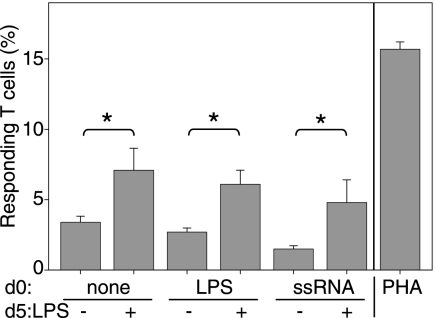FIG. 2.
ssRNA-DCs and LPS-DCs induce proliferation of allogeneic T cells. cDCs, LPS-DCs, and ssRNA-DCs (day 0 treatment) not receiving further stimuli or receiving a late LPS maturation stimulus (day 5) were cocultured with carboxyfluorescein diacetate succinimidyl ester-loaded naive CD4 T cells (ratio, 1:3) from one allogeneic donor. At day 6 of coculture, the different division cycles undergone by T cells were detected by FACS analysis and the number of stimulated cells on the initial sample was calculated. Proliferation induced by cells receiving a late LPS stimulus was significantly greater in all DC preparations (P < 0.05). Results are representative of experiments with at least six different donors. The frequency of responding autologous naive CD4 T cells was in all cases under 2% (not shown). Control peripheral blood mononuclear cells stimulated with PHA are also shown. DCs differentiated in the presence of Dotap induced T-cell proliferation which was not significantly different from that induced by cDCs (not shown).

